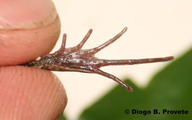|
Description
Physalaemus barrioi is a small frog (26.2 mm SVL) belonging to the P. gracilis species group (sensu Nascimento et al., 2005). Body elliptical. Head triangular, longer than wide. Snout sub-elliptical in dorsal view and acuminate in lateral view. Maxillary teeth present. A large subgular vocal sac longitudinally folded. Vocal slits present. Tympanum concealed. Supratympanic fold poorly developed. Dorsum with glands arranged in longitudinal folds, along with isolated rounded glands. Rounded inguinal glands not prominent. Arms short. Fingers and toes without fringes or webbing. Second finger longer than first. Finger formula: I, IV,II,III. Nuptial excrescences on thumbs. Enlarged rounded subarticular and supernumerary tubercles on hands and feet. Inner and outer metatarsal conical tubercles well developed in hands and feet. Tarsal tubercle present. Finger and toe tips not expanded. Tarsal fold present (see photo). Toes formula: I,II,V,III,IV (Bokermann, 1967; Provete et al., 2012).
The iris is golden in the upper portion and brown in lateral and lower portions. The inguinal region has contrasting yellow, red, and black colorations. Ocellus in the inguinal gland black, with thin white outline. A reddish coloration is observed in the inguinal region, outer portion of thigh and inner portion of tibia. In some specimens, the dorsum is uniformly dark green instead of dark brown (Provete et al. 2012).
The advertisement call is composed of a single, modulated, non-pulsed note with seven harmonics. The mean duration of the advertisement call is 1.24. The minimum frequency is 2.76 Hz, the maximum frequency is 29.14 Hz, the dominant frequency is at the fifth or sixth harmonic. The interval between calls is 0.39 s. Calls are given at a rate of 1.05 calls per minute (Provete et al., 2012).
Orton type IV tadpole: exotrophic, lentic, benthic. Body ovoid in dorsal view and globular in lateral view. Snout rounded in dorsal and lateral views. Eyes dorsal, dorsolaterally directed. Nares dorsally directed, small, elliptical, with a large dorsally positioned projection on marginal rim. Spiracle single, short, and sinistral, inner wall with indistinct ridge, positioned on the posterior third of the body, just below the median line of the body. Spiracle opening rounded, its opening posterodorsally directed. Vent tube dextral, right wall displaced dorsally and free from ventral fin. Dorsal fin low, but more extensive than the ventral one, emerging at the point of insertion of the caudal musculature. Caudal musculature reaching the tail tip, which is rounded. Oral apparatus anteroventrally oriented, emarginated laterally. Marginal papillae in a single linear row laterally, in alternating rows ventrally. Marginal papillae absent anterodorsally. Jaw sheaths narrow, strongly keratinized, the upper jaw sheath widely arched, curved. Lower jaw sheath U-shaped, wider than the upper one. Upper and lower jaw sheaths finely serrated. Keratinized labial teeth gently curved toward the oral opening. Labial tooth row formula (LTRF) 2(2)/3(1) (Provete et al., 2012). Distribution and Habitat
Country distribution from AmphibiaWeb's database: Brazil
The only known population of Physalaemus barrioi occurs in the highlands of the Serra da Bocaina, a segment of the Serra do Mar mountain range in Southeastern Brazil (Provete et al., 2012). Adults of P. barrioi breed in permanent marshes in open areas (Provete et al., 2012). Life History, Abundance, Activity, and Special Behaviors
Males call at night from August to February at the base of small thickets and less often during the day after the heavy rains from October to March. Foam nests are found between September and February anchored at the base of marginal vegetation (Provete et al., 2012). Eggs are white. Tadpoles are commonly found in permanent shallow marshes and small ponds with clay bottoms, in open areas with predominantly herbaceous vegetation from October to April and are active during the day (Provete et al., 2012). Trends and Threats
Apparently, P. barrioi is no longer found in the type locality ("Campo de Fruticultura", currently known as Fazenda Ponte Alta). Specimens occur, however, in other localities within and near the Serra da Bocaina National Park, including Fazenda Bonito (municipality of Arapeí). The type locality has been intensively modified since W. C. A. Bokermann collected the type series (Bokermann 1966). The area was deforested at that time and now supports a secondary forest. Such changes may have resulted in the local extirpation of the species at that location, as currently the species is more commonly found in open montane grasslands in the Serra da Bocaina (Provete et al. 2012). Possible reasons for amphibian decline General habitat alteration and loss
Habitat modification from deforestation, or logging related activities
Drainage of habitat
Subtle changes to necessary specialized habitat
Comments
Provete et al. (2012) provides a thorough description about this species, including karyotype, larval internal oral features and chondrocranium and should be consulted for more details. It also present an extensive review of advertisement call of Physalaemus species.
References
Bokermann, W. C. A. (1967). ''Três novas espécies de Physalaemus do sudeste brasileiro (Amphibia, Leptodactylidae).'' Revista Brasileira de Biologia, 27(3), 135-143.
Gosner, K. L. (1960). ''A simplified table for staging anuran embryos and larvae with notes on identification.'' Herpetologica, 16(3), 183-190.
Nascimento, L.B., Caramaschi, U., and Cruz, C.A.G. (2005). ''Taxonomic review of the species groups of the genus Physalaemus Fitzinger, 1826 with revalidation of the genera Engystomops Jiménez-de-la-Espada, 1872 and Eupemphix Steindachner, 1863 (Amphibia, Anura, Leptodactylidae).'' Arquivos do Museu Nacional, 63, 297-320.
Provete, D. B., Garey, M. V., Toledo, L. F., Nascimento, J., Lourenço, L. B., Rossa-Feres, D. C., Haddad, C. F. B. (2012). ''Redescription of Physalaemus barrioi Bokermann, 1966 (Anura: Leiuperidae).'' Copeia, 2012(3), 507-518.
Originally submitted by: Diogo B. Provete (first posted 2012-07-09)
Edited by: Michelle S. Koo (2012-08-05)Species Account Citation: AmphibiaWeb 2012 Physalaemus barrioi: Bocaina Dwarf Frog <https://amphibiaweb.org/species/3385> University of California, Berkeley, CA, USA. Accessed May 29, 2025.
Feedback or comments about this page.
Citation: AmphibiaWeb. 2025. <https://amphibiaweb.org> University of California, Berkeley, CA, USA. Accessed 29 May 2025.
AmphibiaWeb's policy on data use.
|
